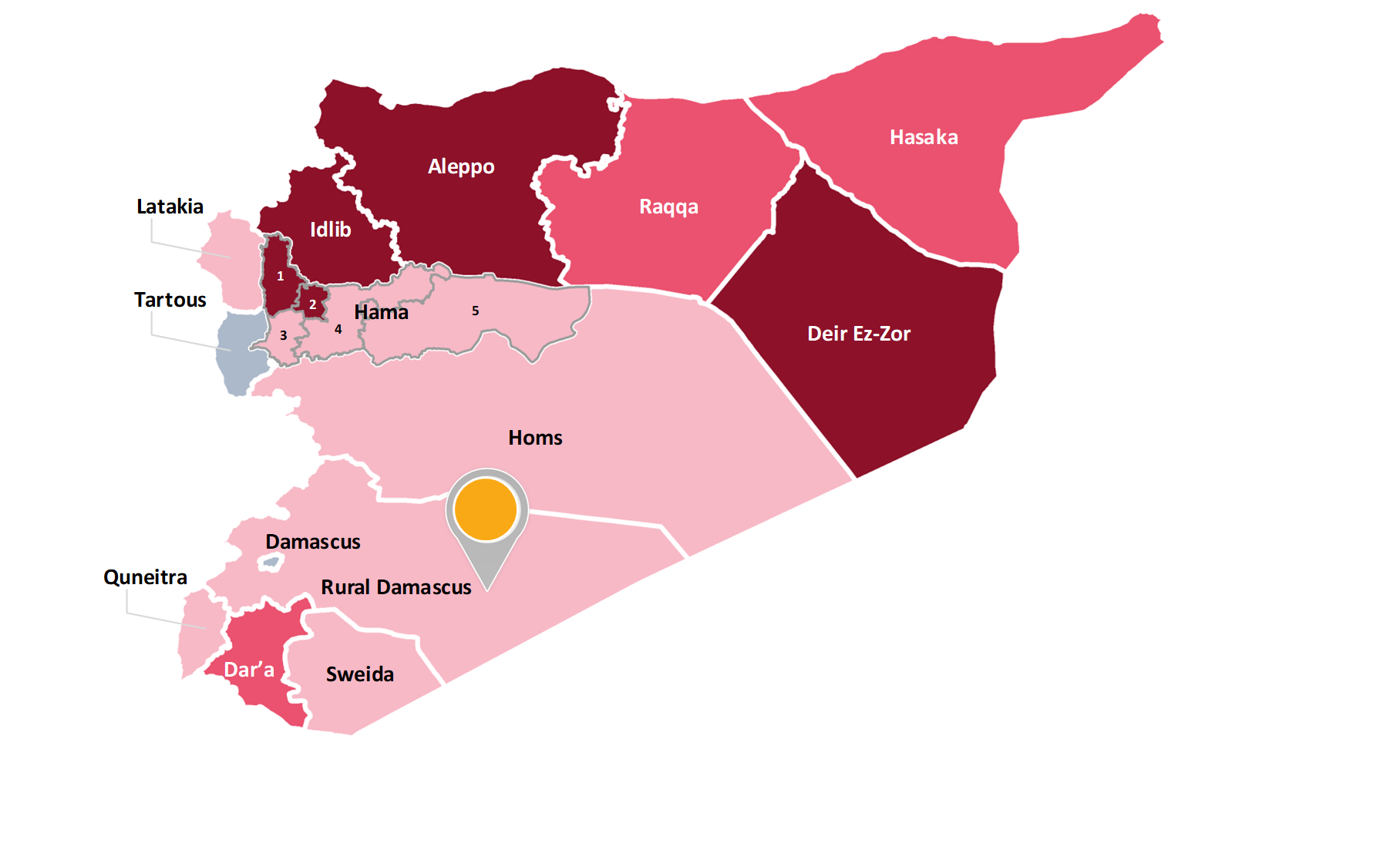[Main COI references: Security 2020, 2.11; Recaptured areas, 3.1]
Rural Damascus [Rif Dimashq] is a largely agricultural governorate surrounding Damascus city. It has international borders with Iraq and Jordan to the east and Lebanon to the west. It borders Homs governorate to the north. To the south it borders Quneitra, Dar’a and Sweida governorates. According to ACLED, Rural Damascus is divided into nine districts: Al Qutayfah, An Nabk, At Tall, Az-Zabadani, Darayya, Douma, Qatana, Rural Damascus and Yabroud. Bordering Damascus city to the east is an area named Eastern Ghouta. The Syrian Central Bureau of Statistics estimated the population of Rural Damascus at 2 957 000 in 2016.

The southern neighbourhoods of Damascus and the Beit Jan area were recaptured in 2018, as well as Eastern Ghouta in April 2018. By then, cities in Western Ghouta, such as Darayya and Muadamiyat, had already signed reconciliation agreements, but with widely varying outcomes. As of March 2020, Rural Damascus governorate was under the control of the GoS.
In addition to GoS forces, Russian military police were posted in the governorate. In December 2019, it was reported that an armed group named Saraya Qasioun had attacked checkpoints, and that it was escalating its militant operations in Eastern Ghouta. As of February 2020, ISIL was still sustaining a support zone straddling the border with Sweida governorate, crossing Rural Damascus and continuing into Homs governorate.
With regard to the situation in Rural Damascus, information on significant developments in the war is limited. Available information refers to an insurgent attack in Khan el-Sheikh having been carried out by means of a VBIED in February 2020 and Israeli aerial attacks on targets near Damascus International Airport and in Rural Damascus.
ACLED recorded 204 security incidents (average of 4 security incidents per week) in Rural Damascus governorate in 2019, the large majority of which coded as violence against civilians. In the first two months of 2020, the number of security incidents in the governorate was 31, amounting to an average of 4 security incidents per week.
During 2019, security incidents occurred in most districts of the governorate, with the largest overall number being recorded in the districts of Duma and Rural Damascus.
In 2019, VDC recorded a total of 92 civilian fatalities and SNHR recorded a total of 53 civilian fatalities in the governorate. Compared to the official figures for the population in the governorate as from 2016, this represents respectively 3 or 2 civilian fatalities per 100 000 inhabitants.
In 2019, 36 000 IDP movements were recorded in Rural Damascus, of which around 32 000 were within the governorate. Most displacement movements recorded during 2019 from Rural Damascus governorate were to Homs governorate. Around 3 000 return movements were recorded to or within Rural Damascus governorate in 2019, of which 2 000 were within the governorate. Return movements from Rural Damascus governorate were recorded mainly to Homs (around 6 000), Tartous and Raqqa governorates.
The hostilities in Rural Damascus and the GoS’s efforts to recapture the area have resulted in a large number of buildings with surrounding neighbourhoods being destroyed or damaged. Damage on other infrastructure was also reported. The living conditions are described as dire, with widely unavailable basic services such as water, schools and hospitals, particularly in Eastern Ghouta. Explosive remnants were reportedly impacted at least 273 communities in Rural Damascus. Freedom of movement was restricted by a network of checkpoints across reconciled areas, including Eastern Ghouta. Extortion, lootings of movables and homes, confiscations of houses, and extrajudicial arrests of persons perceived by the regime to be in opposition to it were also reported.
|
|
Looking at the indicators, it can be concluded that indiscriminate violence is taking place in the governorate of Rural Damascus, however not at a high level and, accordingly, a higher level of individual elements is required in order to show substantial grounds for believing that a civilian, returned to the territory, would face a real risk of serious harm within the meaning of Article 15(c) QD.
|
